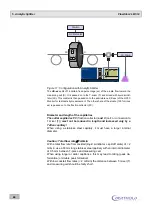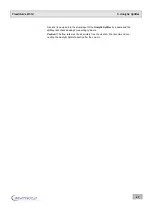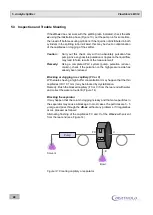
4. Scintillator Pump
FlowStar2 LB 514
40
The capillary path acts as resistance, so that a slight backpressure (ap-
prox. 2 bar at 5 ml/min flow rate) will occur which is required for the exact
switch function of the ball valves.
Caution:
Do not shorten the 0.5 - 1 m long stainless steel capillary.
Do not use any capillary with less than 0.5 mm internal diameter; oth-
erwise there is the danger that capillaries will clog up.
When working with a pump, the liquid scintillator container should be
positioned below the pump to ensure that a negative pressure is cre-
ated in the supply line and the inlet valve is closed. However, if the liquid
scintillator level is above the pump head, the valves of the pump head
are opened so that:
a backflow from the HPLC system can take place or
liquid scintillator flows even if the pump is not in operation..
Aspiration of liquid scintillator
Liquid scintillator (or a detergent solvent) is automatically and continuously
taken up when the supply line is filled with liquid up to the pump head. If
the supply line is not completely filled (e.g. if air bubbles exist) when taking
the pump into operation and occasionally after cleaning the pump, a few
preparations have to be carried out before starting to aspiration new scin-
tillator.
Two alternatives are possible:
a) New aspiration by disposable syringe
For fast aspiration of the scintillator liquid we recommend using a PE
disposable syringe (2 or 5 ml), which is set against the outlet valve of
the pump. Since the shape of these syringes does not fit onto the cone
of this valve, use a 200 µl pipette tip (yellow) as coupling and cut it on
both ends by about 8 mm. Thus you will get an exactly fitting coupling
for syringe and outlet valve.
Position the liquid container on a higher level than the pump to utilize
the law of communicating pipes. The complete supply line is attached
to the pump connecting the liquid container with the pump.
Start the pump by pushing the <
Start/Stop
> button, set the disposable
syringe with prepared pipette tips onto the outlet valve, and take up
liquid slowly and evenly with the syringe. After a short time the liquid
reaches the syringe and you will notice the pressure of the pump push-
ing the piston of the syringe up.
















































